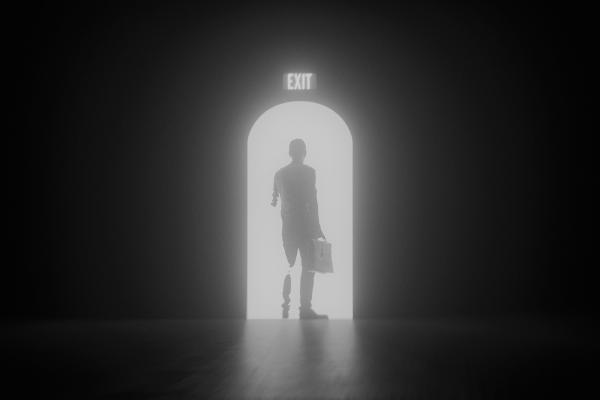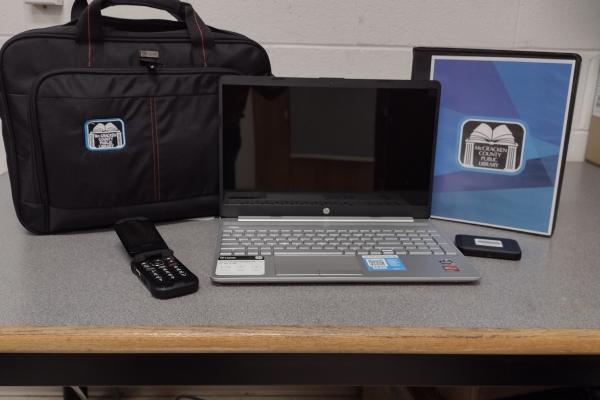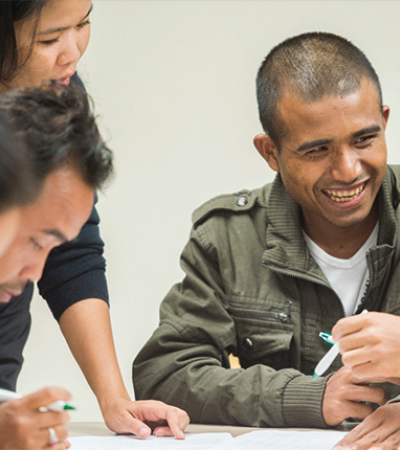Each year, more than 600,000 people are released from state and federal prisons within the United States, and 9 million are released from jail, according to a 2020 ALA report. How can libraries meet the information needs of all these people — especially in 2021, with the pandemic still affecting our daily lives?

McCracken County Public Library in Paducah, Kentucky, has found a new way to reach them: re-entry toolkits, available for checkout, that help the newly freed access resources. The toolkits — created as part of the library’s American Dream Literacy Initiative grant — contain a Chromebook, Wi-Fi hotspot, flip phone and more.
I spoke with Emily Steele, adult and digital services librarian, and Lesley Garrett, bookmobile coordinator, to talk about the importance of these kits in 2021 and how other libraries can connect with local organizations to get resources to formerly incarcerated individuals in their communities.
Were these kits made to address a specific need in your community?
Lesley: The need for these kits grew from a combination of community outreach that we’re continuing to improve. We have a bookmobile that launched in May that visits assisted living homes, domestic crisis shelters, recovery shelters and more. Once the pandemic calms, we want to grow this list. The re-entry kits were built on this community outreach and are also an extension of our digital toolkits and the skill-building toolkits.
Emily: Our library is near a recovery center. Before the pandemic, many people would come by and use the public phone in our lobby. The phone was a huge resource for people in the community, especially those who were formerly incarcerated.
Lesley: Essentially, we wanted the re-entry kits to function in the same way the phone in our library lobby does. When we were closed, we had requests from folks who wanted to come in and use the phone and our computers. We adjusted some of our policies to allow people to use them on a scheduled basis, but now, with the kit, these resources can come along with them.
It’s also important to note that the library is in a central place in town, right across from the courthouse, police station and jail. This is something we need to be aware of in our outreach, especially when serving our formerly incarcerated patrons. We have to be conscious of the police presence and how the library might be perceived because of our location.

What’s in each kit?
Emily: Each kit has a Chromebook, Wi-Fi hotspot, flash drive, mouse, and a flip phone. They can be checked out for one month. The Chromebook is set so it clears after every use, which is why we include the flash drive, so they can save any important documents on it. On the homepage of each Chromebook, we have links saved with resources on basic digital literacy skills, how to build a resume, links to legal aid information and other resources on topics such as housing and obtaining a GED.
The real experiment with these re-entry kits, for us staff, is the phone. Whenever someone returns it, we’ll do a factory reset. It’s important to remind the person who checks out the kit that they won’t always have access to the phone number, because once they return the kit, they won’t have any way to receive messages or calls to that number.
Lesley: The phone is a very important element. Once an individual is no longer incarcerated, especially in those first few days and months, it’s so difficult to do anything without a phone. Calling people for rides, getting calls from potential employers, calling lawyers for legal assistance, the list goes on. For someone already so limited in resources, we hope that these kits give them fewer things to worry about and alleviate some barriers to re-entry.
Emily: We don’t require any proof of incarceration for those who want to check out the kits. Right now, people need a library card to check one out. Of course, library cards are free and quick to get, but we realize this may be a barrier for some. It’s something we will analyze once the program really takes off.
What community organizations do you work with to get these kits out?
Emily: I’m part of the local re-entry council run by the state employment agency, and there are people from a variety of civic groups on the council. We meet once a month, and they’re an important community partner of the library. Being on the re-entry council has really helped with the development of these kits. We did a training where you imagine yourself in the shoes of a formerly incarcerated person and you only have $30 cash and a list of tasks to complete. It was nearly impossible to do. It put into perspective how helpful these kits could be during those first few days and weeks.
We also partner with our local United Way, which helps to spread the word that we have these kits available. I also have made flyers that we mailed to halfway houses and employment agencies. We are mostly relying on referrals for this project and haven’t done any in-house marketing for it yet.
Lesley: I’ve been in conversation with the local jail. Showing them that these kits can be used for job applications is a good angle when talking to jail administration. We hope to get flyers to jail staff so they can let individuals inside know that they are available.
How do you recommend a library start their own re-entry kits?
Lesley: Make sure you are in conversation with your patrons. They know what they need. You might discover that they aren’t looking for a phone or a Wi-Fi hotspot but instead need a completely different set of resources. Maybe people in your community don’t need re-entry kits, but they do need kits for job searchers.
Emily: If you do choose to create your own re-entry kits, be patient with yourself. It was difficult to plan this during the pandemic, and we had a lot of shipping delays. There were also a lot of little details that slipped my mind, like buying cases for the laptops and phones.
Lesley: The resources we have in Paducah are different from a library located in a major city or a small town. If your library is in a medium-sized city, look to a re-entry council or some local organizations that are already working with people experiencing incarceration.
The most important thing is to join the people in your community who are already doing the work. Ask them what the library can do to help with the issues they are seeing. Try to foster relationships and have conversations with people have, or are currently, experiencing re-entry. In our case, the kits grew out of concrete asks from patrons and a visible need.



